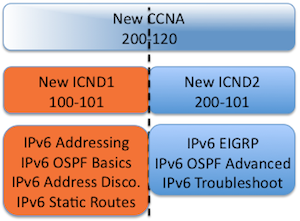#CCENT and #CCNA Fast Start: IPv6 Addressing
IPv6 was formerly in the ICND2 side of #CCNA, but now it’s in the ICND1/#CCENT side. ICND1 includes more than a few IPv6 topics, but the first and often most intimidating topic is the most basic feature: IPv6 addressing. Today’s post introduces the topic, with question and answer posts to follow.
The Exam Topics: Old and New
First, to review the history of what was in the old exams versus the new. Cisco had a few IPv6 exam topics in the ICND2 half of CCNA in the old days, with only one of those specific to IPv6 addressing:
- Describe IPv6 addresses
Cisco moved that exam topic to the new ICND1, with lots of supporting detail. Cisco also added one more exam topic specific to addressing. The following list details those exam topics:
- Identify the appropriate IPv6 addressing scheme to satisfy addressing requirements in a LAN/WAN environment.
- Describe IPv6 addresses
-
- Global unicast
- Multicast
- Link local
- Unique local
- eui 64
- autoconfiguration
Cisco’s new exam topics starting in March 2013 put some IPv6 into ICND1, with IPv6 addressing clearly in ICND1. The exam topics include some that explicitly list “IPv6”, while others use “IP” to refer to all of IP (both IPv4 and IPv6). To show what’s in each side of CCNA, Figure 1 breaks down the topics that I’ve put in the new ICND1 Cert Guide and new ICND2 Cert Guide for IPv6:

Figure 1: IPv6 Topic Breakdown in the ICND1 and ICND2 Books
IPv6 Addressing Overview
IPv6 addresses are long – 128 bits, and up to 32 hex digits long, which is still pretty long. For anyone new to IPv6, the length can be a problem. However, once you understand the addressing, getting around the length of the numbers become manageable. Then, the biggest challenge with IPv6 addresses is figuring out what type of address each IPv6 address is, and the purpose of each address.
IPv6 includes several types of unicast addresses, several types of multicast addresses, and some other special addresses as well. Once you start studying IPv6, you will already know how to look at an IPv4 address and quickly find the IPv4 address class (A, B, C, D, or E), and know that classes A/B/C are unicast, with D as multicast. IPv6 has a completely different set of rules, no address classes, a little bit of math involved in figuring out if an address is a particular type, with different initial values identifying an address as a particular type.
For instance, IPv6 breaks down unicast addresses (addresses used by one interface) into several categories, including:
Global unicasts: used by hosts and routers for an interface to send packets anywhere. Compared to IPv4, these most closely act like public IPv4 addresses, because IANA assigns the address range, and the Enterprise engineer then uses the assigned prefix for all addresses inside the company.
Unique local: used like global unicasts, but more like private IPv4 addresses, in that the numbers are not registered with IANA beforehand. Instead, the Enterprise network engineer chooses a prefix, and then uses that prefix for all addresses inside the company.
Link local: used for packets that flow only over the local link (not forwarded by a router), usually by some overhead protocols. Hosts and routers have the ability to automatically choose their link local addresses.
For instance, Figure 2 shows a diagram of a small network, with global unicast IPv6 addresses listed. Just like with IPv4, a network diagram with IPv6 addresses listed implies that the addresses are some type of unicast IPv6 address. They could be global unicasts, unique locals, or even link locals, depending on the purpose of the figure.

Figure 2: Sample IPv6 Address Plan for a Small Network
For the exams, you need to be as comfortable with these IPv6 addresses as you are for IPv4. For instance, for ICND1, you need to be ready to look at these IPv6 values, and decide which type of IPv6 address is represented by each. The ICND2 exam can them pose troubleshooting scenarios that use these addresses, knowing when each type of address is used for overhead protocols and for packet forwarding.
More on IPv6 Addressing
Next post: a sample question on IPv6.

[…] Introduction to this topic as it exists in the new CCENT and CCNA exams: […]
[…] Link to the brief topic introduction […]
[…] Link to the brief topic introduction […]